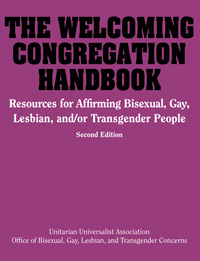The GLBTRT has been reviewing books and movies in its newsletter since the early 1990s. Trace the evolution of queer publishing through these historic reviews. This review was originally published in Vol. 3, No 3 & 4 Spring/Summer 1991.
 The Welcoming Congregation: Resources for Affirming Gay, Lesbian and Bisexual Unitarian Universalists. Scott W. Alexander, Editor. Unitarian Universalist Association, 1990. (ISBN 1-55896-190-9).
The Welcoming Congregation: Resources for Affirming Gay, Lesbian and Bisexual Unitarian Universalists. Scott W. Alexander, Editor. Unitarian Universalist Association, 1990. (ISBN 1-55896-190-9).
Written as a guide for the Unitarian Universalist Association of Churches, this sourcebook should change its title to The Welcoming Community: Resources for Affirming Gay, Lesbian, and Bisexual Lifestyles. The book brings together in a sensitive, factual prose the realities of the gay, lesbian, and bisexual lifestyles. It gives to Christian and non-Christian gay, lesbian, and bisexual individuals a useful resource tool in combating “Biblical Fundamentalism” which continues to plague the culture.
The Welcoming Congregation makes a commitment to “celebrate the lives of all people and their ways of expressing their love for each other” and seeks to, within its scope, create a guideline for a spiritual environment which will be “inclusive and expressive of the concerns of gay, lesbian, or bisexual persons at every level of congregational life.”
Each congregation begins this process by exploring their own feelings toward their gay, lesbian, and bisexual brothers and sisters in a questionnaire. After reviewing the questionnaire results, facilitators direct the congregation through a series of awareness workshops which deal with the many facets of the gay, lesbian, or bisexual lifestyle. From homophobia to AIDS fear, the workshops present to the community a chance to see what it means to be gay, lesbian, or bisexual in a predominantly heterosexual world. It presents several touching “coming-out” stories which could be useful to youth struggling with their own sexual identity. It culminates with the concept that gay, lesbian, and bisexual people need heterosexual allies who are supportive and that congregations that choose to be “welcoming” can make a difference.
This book should be a ready reference source for general information on the gay, lesbian, or bisexual experience. It should be obtained for theology collections as a required reference for pastoral training within all Christian denominations. It would be useful for any organization seeking to become a “welcoming community.”
Reviewed by Charles Whitlow
AT&T Tax Libraries
Morristown, New Jersey
